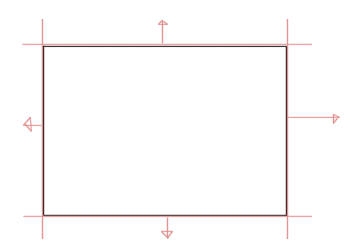
As already mentioned, Handles allow for multiple trees within the PRIM section. Here I will explain how this can be used to make an object solid, by adding a collision volume.
To make an object solid, we must define its sides - e.g. for a house we'd have 4 walls, and 2 'sides' for the roof. This will enclose the entire house behind the 6 'sides', which are actually planes.

With those 6 planes (arrows represent the direction of the plane), the house is enclosed. If we were to test a point in space against these planes, we notice that when the point is behind *every* plane, it is actually inside the house - i.e. in collision with the house. If the point is in front of even just one of the planes, a collision has not occured.
Here's a plan view of the 4 walls of
the house, where the red lines/arrows are the 4 planes:

So how does this fit into the 3DO ?
Like this (assuming you're familiar with the nodes):
Node 4, 1 child
Node 4, 6 children (one for
each of the planes)
Node 6
(referencing the first plane)
Node 10, with 1 number
Node 6
(referencing the second plane)
Node 10, with 1 number
Node 6
(referencing the third plane)
Node 10, with 1 number
Node 6
(referencing the fourth plane)
Node 10, with 1 number
Node 6
(referencing the fifth plane)
Node 10, with 1 number
Node 6
(referencing the sixth plane)
Node 10, with 1 number
See how there is one type 6 -> type 10 node, per plane. The number in the type 10 node defines how the cars collide with the object - e.g. soft, solid, bouncy, sticky, etc. (not sure of the exact numbers...)
Some notes:
* You can only define concave collision
volumes - e.g. a cube is okay, so is a sphere, but a cube with a hole in the
middle is not okay, because the surfaces double back in on themselves, creating
a confused object.
* But ! You *can* have multiple collision volumes in each object. See the tree above - the first node has only one child - e.g. one collision volume. By having multiple children (each the same layout as the example), you can create collision volumes such as the cube with a hole. E.g. a bridge generally has two uprights, and a cross piece. By using 3 collision volumes, this will work nicely.
* It is not necessary to completely enclose an object - if a cube is standing on the ground, why bother enclosing the bottom ? The cars cannot go underground ! Similarly, something like a flag pole can do without a top, because the chances of a driver landing on top of the pole are fairly remote :-)